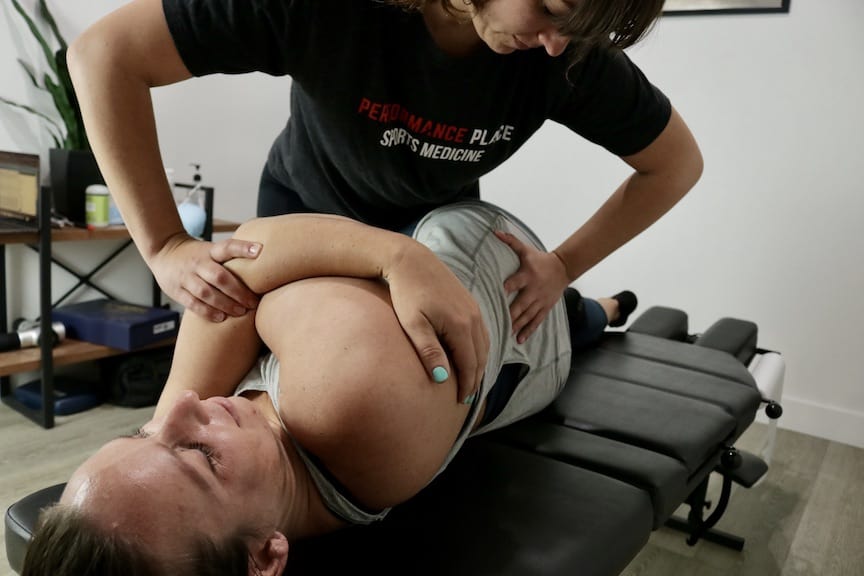20 Reasons To See A Sports Chiropractor
The Sports Chiropractor: A Specialist Providing Comprehensive Athletic Care
Chiropractic Care Philosophy
The Sports Chiropractor: A Natural Extension of Chiropractic Care
Which Professional Athletes Use a Sports Chiropractor?
What Are the Educational Requirements of a Sports Chiropractor?
What Kind of Care Does a Sports Chiropractor Give?
What Types of Treatments Do Sports Chiropractors Offer?
How Do Sports Chiropractors Compare with Other Sports Medicine Providers?
Sports Chiropractors versus Physical Therapists (PTs)
Sports Chiropractors versus Massage Therapists
Sports Chiropractors versus Medical Doctors (MD and DO)
Sports Chiropractor versus Chiropractor
How Do I Know if I Should See a Sports Chiropractor?
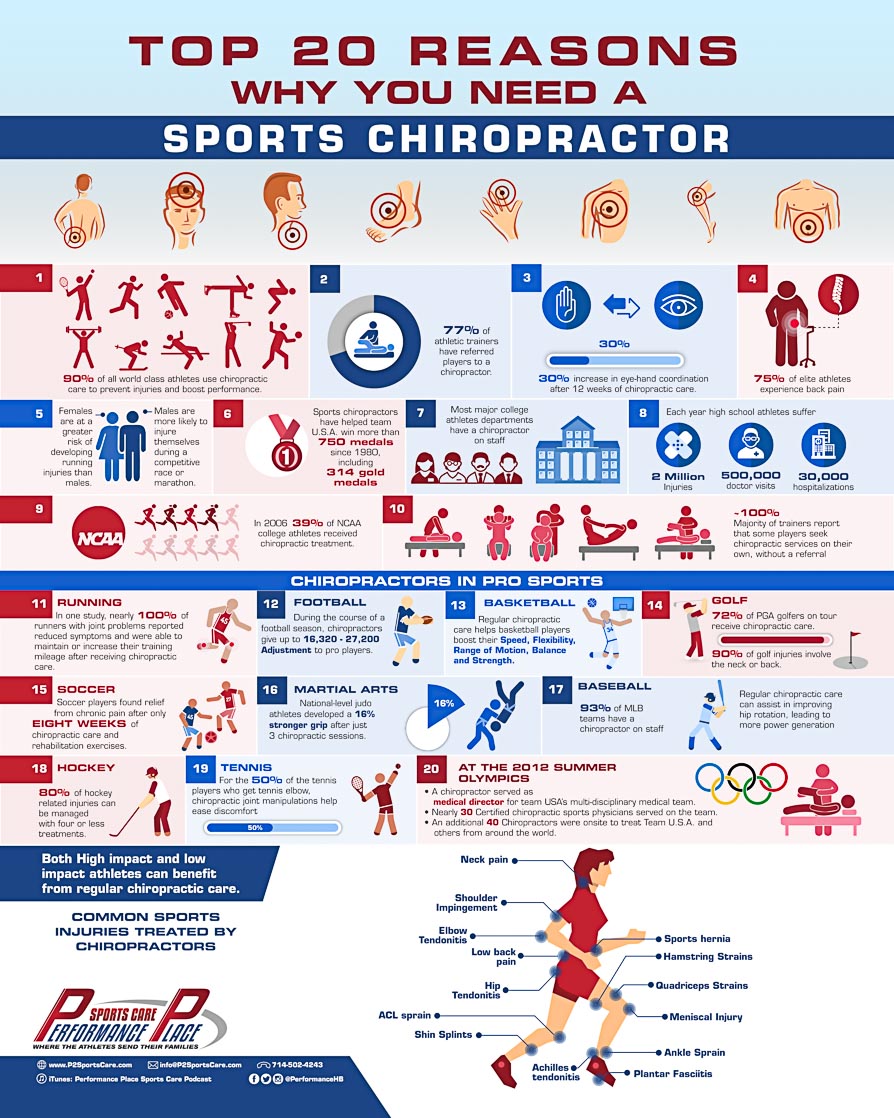
Share this Image On Your Site
The Sports Chiropractor: A Specialist Providing Comprehensive Athletic Care
Once thought to be an “alternative” form of medicine, today, it is very much considered mainstream. Chiropractors are now the third largest group of medical providers in the United States behind physicians and dentists.1
A sports chiropractor is a highly trained and extremely knowledgeable provider of chiropractic medicine that has advanced expertise in both the prevention and rehabilitation of sports related injury, advanced training in the use of musculoskeletal imaging studies, in addition to expert level knowledge in sport-specific strength and conditioning techniques and optimal biomechanics.
This article will help you better understand exactly what a sports chiropractor is and does, discuss the rigorous educational requirements of a sports chiropractor, compare and contrast the profession with other sports medicine practitioners, and lastly, help you decide if and when you need to seek the care of a sports chiropractor.

Chiropractic Care Philosophy
Since that time, chiropractic care has gained recognition as a legitimate, therapeutic form of medical treatment in all 50 states as well as Mexico, Canada, Great Brittan, Japan, Switzerland and Austrailia.2
The philosophy of care in chiropractic medicine is focused on the overall wellbeing and optimized general health of an individual.

The cornerstone of chiropractic care is spinal manipulation. It is a highly technical and specific method used to re-align the vertebrae, the bones of the spinal column.
Spinal manipulation restores proper musculoskeletal structure (alignment), which allows the body the opportunity to heal itself.
In addition to spinal manipulation, many chiropractors also incorporate therapeutic and rehabilitative exercises along with nutritional, dietary and lifestyle modification counseling into their care.
Chiropractic medicine is a non-surgical approach that emphasizes drug-free pain relief and approaches evaluation and care from a global perspective, employing many different modalities to achieve and maintain optimal health.
It is a branch of medicine that mainly uses evidence-based practices, meaning that it employs techniques and treatment algorithms that have been shown by controlled research studies to be statistically effective for the problems they treat.
Today, many patients are under the care of both a medical and chiropractic physician.
While both forms of medical care offer unique and different perspectives on optimal treatments to maintain health, they often compliment one another.
Patients find they like they the more global approach to ideal health and appreciate the unique perspectives and recommendations that both types of physicians can offer.
Chiropractors employ drug-free modalities to treat pain.
The Sports Chiropractor: A Natural Extension of Chiropractic Care
While these physicians are certainly experts in the anatomy and surgical repair of musculoskeletal injuries, many athletes were interested in care that emphasized the prevention of injury and optimization of performance.
Because of their foundational training in how structure relates to function, chiropractic physicians were a natural fit for this role.
In fact, the sub-specialty of sports chiropractic was brought to the forefront of professional sports in 1976, when Olympic athletes started working with chiropractors specializing in sports medicine care. Shortly after in 1980, the first official appointment of a sports chiropractor to the U.S. Olympic Committee (USOC) Division of Sports Medicine was made.3
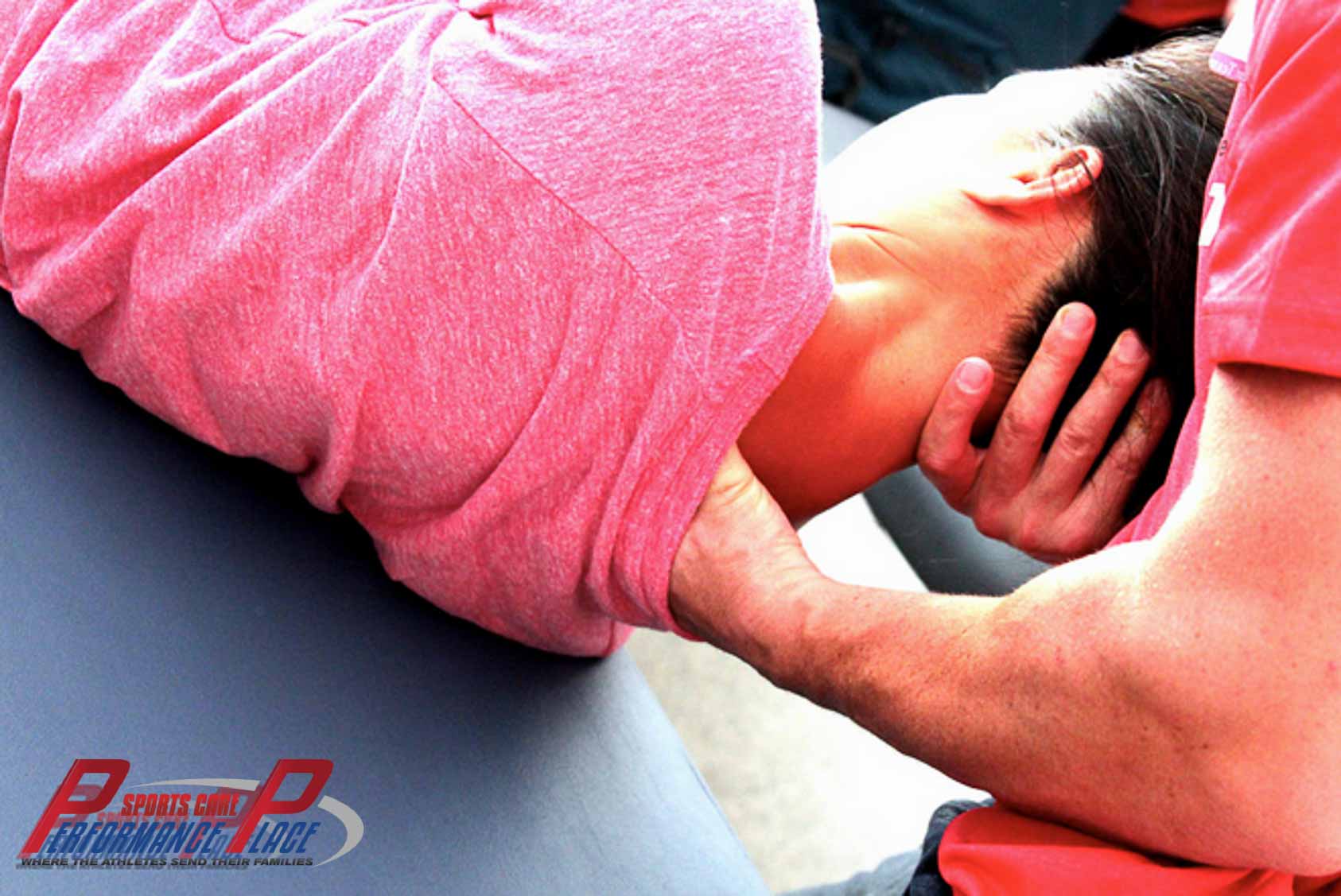
Since then, sports chiropractors have been a staple of the training regimens of Olympic athletes. They have also become part of the training programs for many other professional athletes.
Most Major League Baseball teams also incorporate routine chiropractic care into their training regimens.4
While all of these athletes still depend on traditional medical care in addition to the care of a sports chiropractor, many professional sports organizations now recognize the important contributions that an interdisciplinary training approach brings to elite athletes.
While the road to this harmonious union hasn’t always been smooth, the enhanced training and injury prevention that the addition of sports chiropractic care provides for these athletes has cemented its place in the world of professional sports.
Which Professional Athletes Use a Sports Chiropractor?
- Evander Holyfield
- Joe Montana
- Jerry Rice
- Roger Craig
- Chi Chi Rodriguez
- Dennis Alexio
- Aaron Rodgers
- Vernon Davis
- Patrick Willis
- Justin Smith
- Phil Mickelson
- Jack Nicklaus
- Arnold Palmer
- Jordan Spieth
- Barry Bonds
- Cole Hamels

How can spinal manipulation be so important to elite athletes?
If you’re asking yourself this question, you’re missing the forest for the trees.
Yes, sports chiropractors are Doctors of Chiropractic, but they offer much more than just spinal manipulation!
The comprehensive care they can provide goes SO much further for their patients than that!
Imagine having someone who is highly trained in the anatomy and musculoskeletal structure of the body who also has in depth knowledge of exercise physiology, strength and endurance training, nutrition, rehabilitative and therapeutic exercise, deep tissue massage and advanced soft tissue techniques, all in combination with an in depth understanding of the biomechanics, balance, stability and muscular coordination necessary to play elite level sports.

What Are the Educational Requirements of a Sports Chiropractor?
This training includes a minimum of 4,200 hours of curriculum that consists of classroom, laboratory and clinical internship time.
These requirements are very similar to those for medical physicians, both allopathic and osteopathic (MD and DO).2
In addition to this basic training in chiropractic medicine, a sports chiropractor can have two further educational certifications: CCSP® and DACBSP®.
CCSP® stands for Certified Chiropractic Sports Physician and is a certification that requires additional training and testing beyond the doctoral (DC) degree.
A DC is eligible to sit for the exam after one of the following educational requirements is met:
- Completion of a minimum of 100 hours of postgraduate education in a Certified Chiropractic Sports Physicians program taken at an accredited college
- Completion of a Masters of Science (MS) program in exercise or sports science or equivalent program from an accredited college
- Completion of the first year of a sports medicine residency program at an accredited college
- Possession of current certification as an Athletic Trainer (ATC)
To sit for the DACBSP® certifying exam, the CCSP® certification is pre-requisite and the candidate must also have an active DC license. In addition, one the following advanced educational criteria must also be met:
- Active CCSP® certification with completion of a minimum of 200 hours of postgraduate education in the DACBSP Program from an accredited chiropractic college
- Active CCSP® certification with completion of a Masters of Science (MS) degree in an equivalent program in the domain of sports medicine
- Completion of a sports medicine residency program
The sports chiropractor is much more than a DC; the advanced training they receive through the certification process gives them expert level knowledge in the field of sports medicine.
What Kind of Care Does a Sports Chiropractor Give?
No matter who what level your at, a sports chiropractor can take care of everything from rehabilitation of an injury to helping you achieve a PR.
Many sports chiropractors treat common, overuse injuries. Runners who suffer with hip, knee or foot injuries or pain, overhead athletes like volleyball, baseball and tennis players who have shoulder or upper extremity injuries or pain and sports traumas, even concussions are managed by sports chiropractors. They can evaluate, diagnose and treat just about any sports related injury or performance issue.
Sports chiropractors are trained to use multiple imaging modalities such as x-ray, CT, MRI and Musculoskeletal Ultrasound to evaluate for injury and track the progress of rehabilitation.


Most sports chiropractors are athletes themselves, so they may gravitate towards or work more with a certain type of athlete just because they have first hand knowledge of the sport’s commonly incurred injuries and its physical demands.
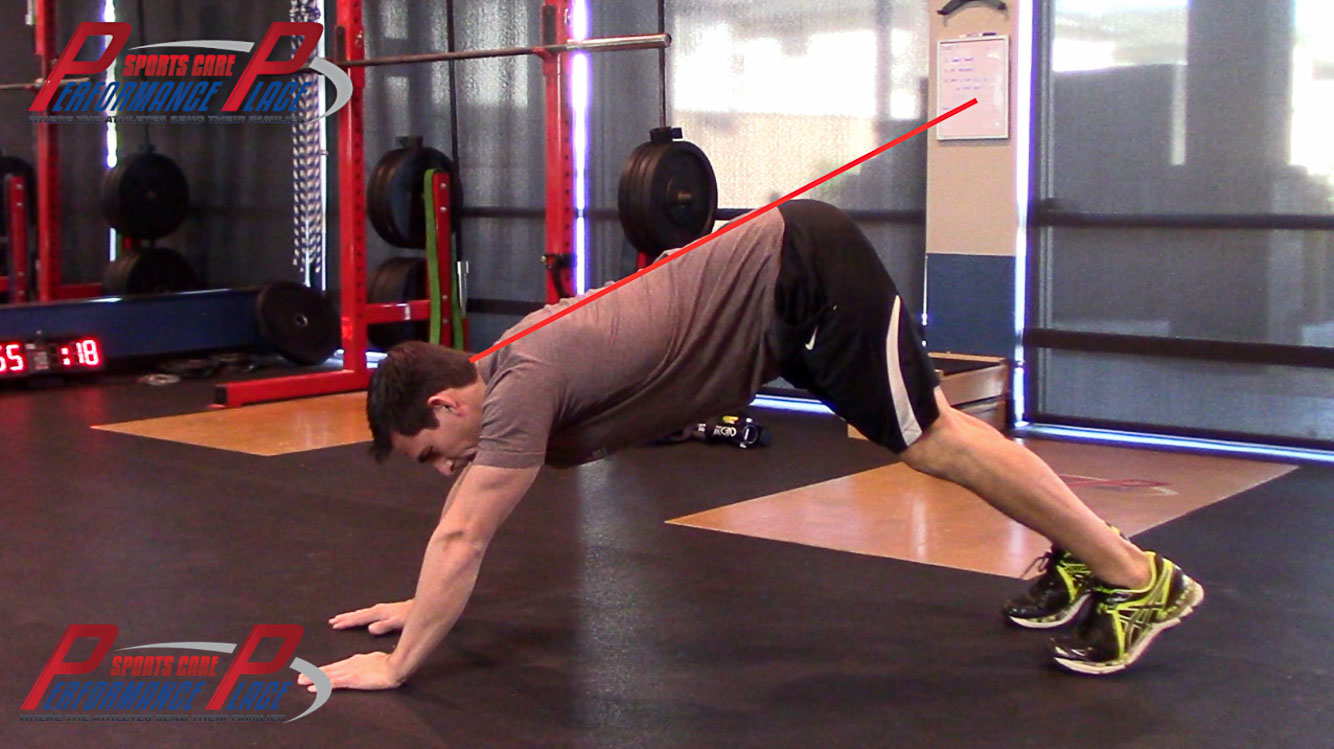
They are hands on teachers with in-depth knowledge of anatomy, strength and endurance training as well as correction of improper biomechanics through strength and conditioning. They’re intimately familiar with the techniques they use because they use them themselves.
A good sports chiropractor understands the fundamental biomechanics involved in your sport.
This in-depth knowledge allows them to not only better diagnose and differentiate common sports injuries, but also formulate a more effective treatment plan if you are injured, or better yet, get you on a plan to prevent injury.
What Types of Treatments Do Sports Chiropractors Offer?
Here are just a few of the treatments that you may get from a sports chiropractor:
- Muscle work
- Exercise rehabilitation
- Strength training
- Kettle bell exercise
- Barbell exercises
- Stretching activities
- Core strengthening exercises
- Taping
- Advanced soft tissue techniques (Active Release Techniques®, Graston, etc)
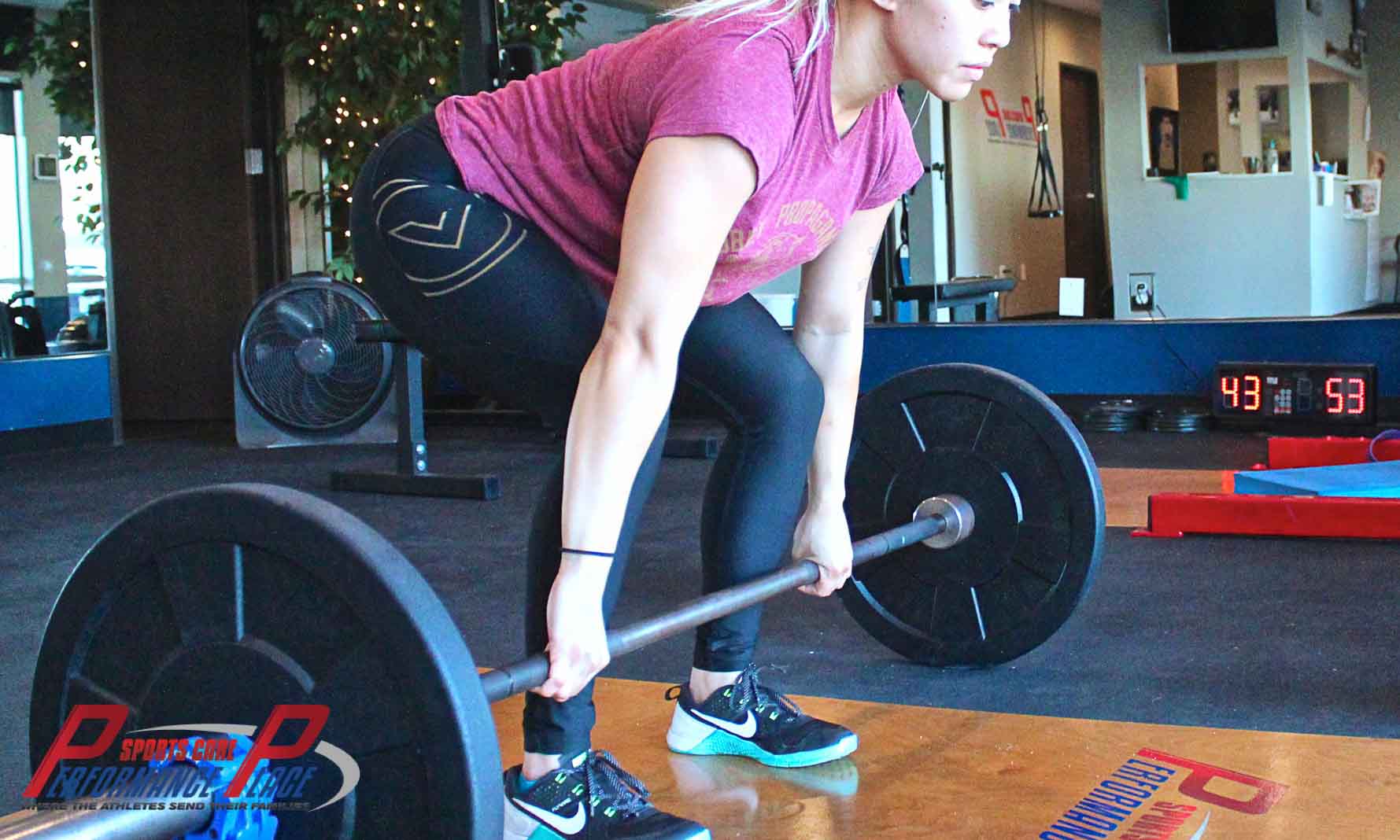
Sports chiropractors may also employ many other traditional therapies such as ice, rest, compression and immobilization depending on the injury or condition being treated.
Because the overall focus and goal of a sports chiropractor is to promote and restore proper biomechanics, strength and optimal function, they are the perfect choice for any athlete at any level! The expertise they provide can be applied to almost all aspects of athletic training which makes them invaluable in the world of sports medicine.
How Do Sports Chiropractors Compare with Other Sports Medicine Providers?
The point of this section is not to dissuade you from using the services of any of these other highly trained, skilled professionals.
Again, there is value in having an interdisciplinary approach to care.
Rather, our goal is to relay some points of education for you to consider if you’re not sure whom you need to see, and when and why you should seek their help.
Sports Chiropractors versus Physical Therapists (PTs)
Let’s start with education first. We really detailed the education requirements of sports chiropractors in the previous section. Most PT programs now offer doctorate level educational degrees (DPT).
This means that in addition to an undergraduate degree, a PT will spend 3 years in a post-graduate program. From there, they may also go on to specialize in certain areas of care by completing a residency program.
Both PTs and sports chiropractors are board-certified by their respective national accrediting associations, and each must have valid licensure to practice in his or her state.
Both may use soft tissue manipulation techniques and joint adjustment/mobilization in their therapeutic regimens.
Many sports chiropractors are trained in the use of biomechanics, improvement of movement patterns, exercise rehabilitation, physiotherapy, stretching, passive modalities (ice, heat, compression, etc), strength and resistance training. PTs may have this training and knowledge as well, but it can vary depending on their area of specialty.

While PTs specializing in sports medicine may also share this expertise, sports chiropractors have deep insight into the areas of balance, muscle coordination and memory, core stability and proprioception and how these facets of movement affect training, performance and the potential for and prevention of injury. PTs may specialize in the treatment of neurologic disorders and injuries such as Parkinson’s, Multiple Sclerosis, Cerebral Palsy and Traumatic Brain Injuries.
PTs and sports chiropractors can both see and treat patients of all ages, but PTs may also be specialized in areas such as women’s health and geriatrics. PTs may also specialize to treat patients suffering with long-term, chronic debilitating conditions such as Heart Failure and Chronic Obstructive Pulmonary Disease (COPD).

In terms of injury rehabilitation, both PTs and sports chiropractors are excellent choices.
Sports chiropractors are DC’s, which means they all have general training in nutrition and how it relates to health. PTs may or may not have this foundational knowledge, depending on their undergraduate background and area of residency training.
Sports Chiropractors versus Massage Therapists
A massage therapist may be on staff at a chiropractic office; they often are part of the care team for professional athletes in addition to a sports chiropractor.
Massage therapists who successfully complete a training program at an accredited massage therapy school can apply and obtain licensure to practice in their state usually after passing a nationally standardized licensure test.
Not all states require licensure, however. A board exam is available for massage therapists, but currently, it is a voluntary test for those wishing to seek higher credentialing as a massage therapist.
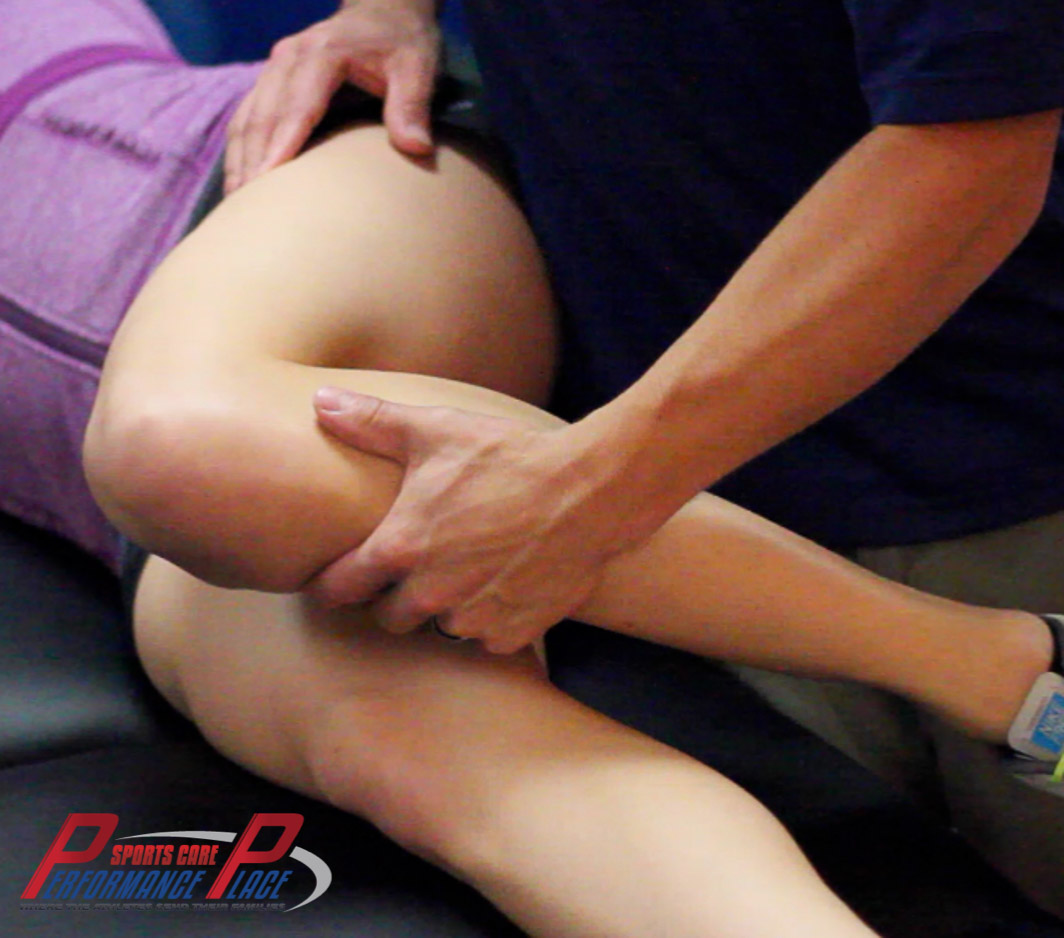
Sports chiropractors are not massage therapists, but are often trained in and use deep tissue massage in their care routines.
These techniques differ from deep tissue massage in that they reduce and prevent adhesions, which is scar tissue within the muscle. Any and all of these techniques are important to the rehabilitation and prevention of sports injury in athletes, and should be part of their training and routine care.

Sports Chiropractors versus Medical Doctors (MD and DO)
First though, let’s hash out some of the differences between an MD and DO. Without getting too specific, both are medical doctors. Both apply for and train in the same residency programs and both will sit for the same national board exams.
In short, in the real world, you may not see much of a difference in an MD or DO, except for the different letters behind their names.
MDs can and do specialize and practice in both orthopedic and sports medicine. DOs are “Doctors of Osteopathic” medicine. They go to osteopathic schools, where their training is essentially the same as that of an MD, with the exception that their curriculum also includes Osteopathic Manipulation (OM).
OM is a practice similar to Chiropractic in that the underlying principles are that function is dependent upon structure and the body has an innate ability to heal itself. Osteopaths can almost be thought of as a mix between an MD and DC.
While some DOs incorporate OM heavily into their practices, but many do not. Many DOs share the same function as MDs in the medical setting. DOs can specialize and practice in any area of medicine, not just orthopedics and/or sports medicine.

Many MDs are great at diagnosing but they will have to “hand-off” the application of non-medicated types of treatment plans.
Medical doctors are aware of soft tissue techniques, but do not practice them themselves; they may or may not routinely refer to massage therapists or PTs for this. They also may have some knowledge of nutrition, but often refer to a registered dietician for counseling and services in this area.
Non-surgical, primary care based sports medicine physicians have advanced training and skills at evaluating and treating sports injuries; while their training places heavy emphasis on orthopedic surgery techniques, they don’t do surgery.
The surgical sports medicine physician is typically an orthopedic surgeon whose fellowship training involves advanced, specialized surgical training to repair specific orthopedic injuries (i.e. shoulders or knees).
Obviously, there will be times when surgical care is the only option for an athlete, but a sports chiropractor can be heavily involved in the routine training and conditioning programs, preventative and rehabilitative care that they need as well.
Sports Chiropractor versus Chiropractor
Generally speaking, chiropractors will fall into one of two groups: conservative or liberal.
These are often referred to as “straights” or “mixers” respectively. Conservatives or “straights” tend to focus their practices almost exclusively on spinal manipulation.
Liberals or “mixers” use a much more broad range of interventions and treatment modalities for their patients.
The main difference between straights and mixers is twofold: philosophical approach and mainstream usage and acceptance. At one end of the spectrum are the straights and at the other, the mixers. Many chiropractors fall in between as well.
The number of these types of practitioners in the U.S is low. They comprise about 15% of all chiropractic providers.6 These practitioners often completely reject mainstream medicine and therefore, are really not integrated into the modern healthcare system.
On the opposite end of the spectrum are the mixers.
These chiropractors provide a wide array of therapies and use many diagnostic tools to aid in the evaluation and care of their patients. They may provide homeopathic remedies such as acupuncture, herbal remedies and natural supplements for their patients. They are skilled at the use of imaging exams such as x-ray to help diagnose, treat or reassess a patient’s condition or response to treatment. They may work with a PT or recommend exercise as part of the therapeutic regimen. While they still believe in and use spinal manipulation in their practices, they also very much believe in following mainstream medical research when evaluating and treating their patients.
These practitioners are highly integrated into the modern healthcare system; they truly see themselves as complimentary, yet alternative medical providers.
The sports chiropractor is very much a mixer.
By incorporating the basic chiropractic principles into an evidence-based practice that focuses on strength and conditioning, exercise rehabilitation and physiotherapy, sports chiropractors have a broad and deep range of knowledge and skill that blends many elements of evaluation and care.
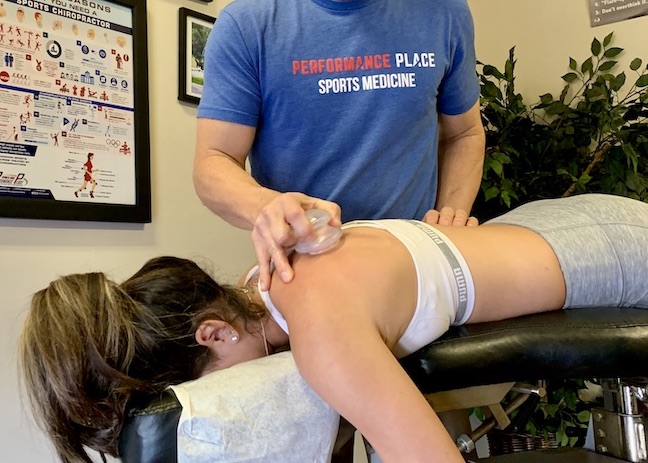
How Do I Know if I Should See a Sports Chiropractor?
Whether you are a recreational, amateur or professional athlete, seeking to rehabilitate or prevent an injury, a sports chiropractor can help you. Or maybe, you just want to find a great strength and conditioning coach with advanced knowledge of your sport that can help you train to get to the next level or help prevent common, overuse injuries in your sport?
If so, a sports chiropractor has the right background for that too.
Hopefully, you’re not an athlete who can’t get a straight answer, or has seen numerous providers, yet come up empty on a definitive diagnosis or treatment plan that’s helped you.
But if you are, a sports chiropractor may be just the kind of provider you’re looking for.
By now, you should have a very good list of questions put together when meeting with someone to help you decide who you want to take care of you and why. Know what your goals are and what services and skills are important to you. Make sure you ask enough detailed questions of your prospective practitioner to ensure he or she is a good match for you.
Please give us a call today.
In the end, you are the only one who can make the decision on what care is the best for you. And one step further, even with the help of a skilled sports chiropractor, your progress and success in any training or treatment program depends on the work you put in.
Working with a sports chiropractor, however, can be a big factor in your overall success.
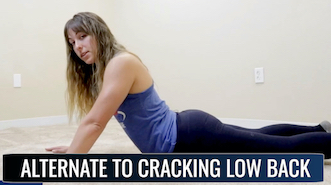
What Do Sports Chiropractors Do?
Sports chiropractors are “primary care” doctors for musculoskeletal conditions. Lower back pain, stiff neck, thrower’s shoulder, piriformis pain, hip flexor tension, tight hamstrings, you name it, and it’s right up their wheelhouse. Most of these conditions can be treated effectively without medication, injections, or surgery.
A chiropractor specializing in sports medicine can guide your recovery by gathering clues about your condition through a detailed history and a thorough spine and joint orthopedic examination.
In addition, all new patients will have a neurological and physical examination. Many patients will also receive mobility, stability, and strength testing based upon their reason for treatment.
Based upon the chiropractor’s education and training, they can also help you recover from sciatica, knee pain, plantar fascia pain, Carpal Tunnel Syndrome, and much more.
Make sure to call ahead of time. Ask about the doctor’s experience in treating your condition, as not all chiropractors are training in treating all areas of the body.
Consider a chiropractor specializing in sports medicine as a “quarterback” for your musculoskeletal health. They can make referrals for MRIs, X-rays, and consultations for other specialists such as orthopedic doctors, neurologists, rheumatologists, GI, and much more.
You go to your dentist for your teeth, your dermatologist for your skin, and your sports chiropractor for spine, shoulder, and hip pain.
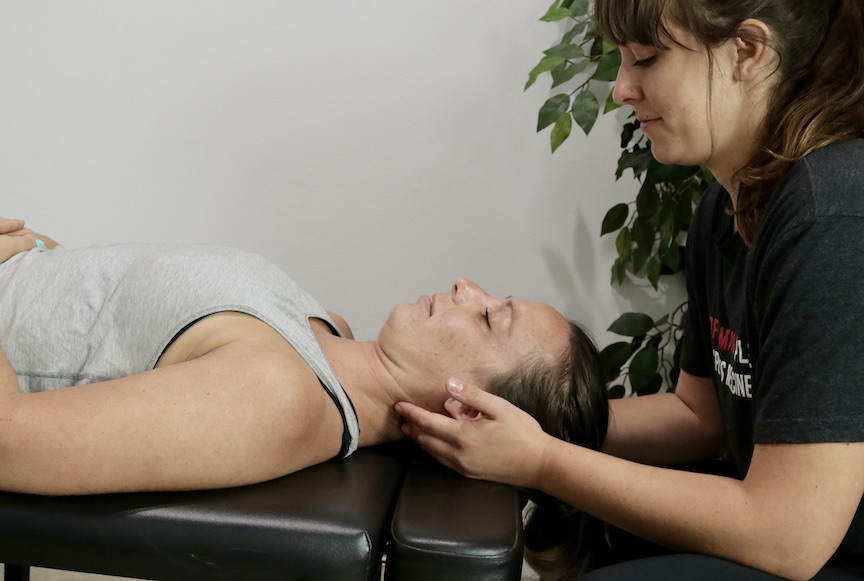
Are chiropractors quacks?
While we can discuss this topic from a research standpoint, it may be best to use online public reviews as the best indicator of “quackery.” Perform a general Google search of the “Best chiropractor near me” and see what comes up.
I’ve conducted my search below:



As you can see, many people are getting great results, reducing pain, and glad to give public testimonials about their experience. I’d encourage you to do this on your own. Count how many success stories you find versus the bad ones. Make it a game and keep score! I’d venture to say you’d see 95% are 4-5 star reviews with a great story of recovery.
Is there research to back chiropractic methods?
Yes
Research of the chiropractic methods (adjustments, corrective exercise, physiotherapy, diagnosis, and examination skills) have been published in a various peer-reviewed journal. An example is Spine, which has contributing papers from all medical disciples who treat spine disorders. Chiropractors have also been published on Strength and Conditioning websites like the NSCA site. The NSCA is one of the most reputable strength and conditioning certifying bodies.
A statement labeling all chiropractors as quacks is a bias rooted in the past. Some people generally lack an understanding of what the chiropractic profession can offer as experts in musculoskeletal disorders. I’d encourage you to search for a chiropractor by you who performs the current standard of care taught in all chiropractic schools.
- Medical history taking
- Physical examination
- Regional orthopedic examination
- Neurological workup (dermatomes, myotomes, reflexes, and pathological reflexes)
- Palpation
- Movement Examination
- Reports of Findings
- Diagnosis
All of these and more are performed before offering a treatment plan. All patients are screened for contraindications for spinal manipulation before application, such as cord compression, Rheumatoid arthritis, bone weakening disorders, infection, and more).
Should Athletes Go To A Chiropractor?
Not all athletes NEED to see a chiropractor. While a chiropractor can be an asset to an athlete, most of their performance is rooted in skills development over the years in their sport, strength gains in the weight room, and field awareness.
An adjustment did not win the game for you. You won it with your hard work! An adjustment is a small part that can be useful when used in the right situation.
While I would love to claim all athletes need a chiropractor, it is untrue. However, if you have a musculoskeletal disorder that robbed you of performance in your sport, you may want to make an appointment.
A sports chiropractor can help with the reduction of pain, improving joint range of motion, and better recovery (sleep without pain). Sports chiropractors are specialists in muscle and joint pain. Make an appointment and see for yourself!
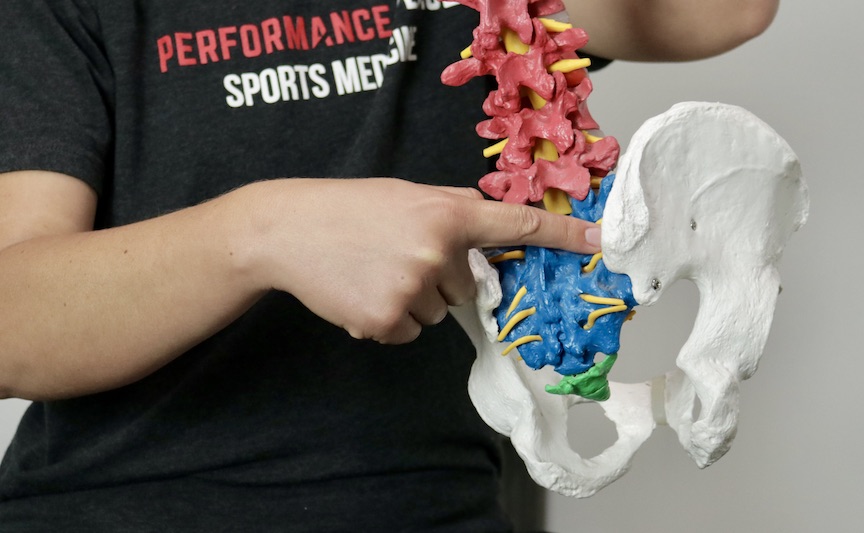
- http://www.active.com/fitness/articles/how-chiropractic-and-massage-therapy-ease-sore-muscles. Accessed 10/18/16.
- https://www.acatoday.org. Accessed 10/23/16.
- https://en.wikipedia.org/wiki/Sports_chiropractic. Accessed 10/18/16.
- http://probaseballchiros.com/about/. Accessed 10/25/16.
- http://acbsp.com/node/14. Accessed 10/23/16.

